Integrated graphics faceoff: Intel Iris Pro 6200 vs. AMD Radeon R7
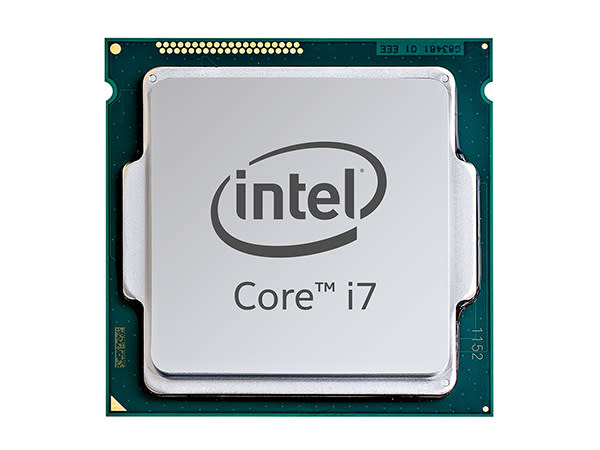
The best of integrated graphics
For rig builders who are looking to build a desktop PC without the need for a discrete graphics card, they primarily have two current desktop processor series to choose from; the AMD A-series desktop APUs or the Intel 5th or 6th generation processors. For the curious case of Intel, its most current 6th-gen Skylake desktop CPUs feature the Intel HD Graphics 530 GPU, which is far from bring the best in class. In fact, the current best graphics class of GT3e is featured in Iris Pro Graphics family. As such, the Intel Iris Pro 6200 graphics engine is the best that Intel has to offer and this is featured in the 5th generation Intel Broadwell Core i7-5775C as its host CPU.
In the AMD camp, the company refreshed its A-series APUs in mid 2015 with the new Godavari APUs. The top-dog (as of December 2015) is the A10-7870K and its Radeon R7 integrated graphics engine. So in comparison to the Intel camp, AMD gets points for its product clarity; i.e., if you need its top-end integrated graphics solution, just go for its top-end desktop A-series processor.
Next, we touch on some finer points of each of the chosen processor before we put them to the test.
Intel Core i7-5775C (Broadwell)
The Intel Broadwell desktop processors are marketed as 5th generation CPUs and they were fabulously late to the market as they were only released in the second quarter of 2015. They were originally announced in March 2014 and were expected to be available by the end of the same year. Sadly, they were delayed and with the launch of the 6th generation Skylake processors, the 5th gen Broadwell desktop CPUs were left in the shadows. All isn't lost as there are still two attractive features of the Intel i7-5000 series CPUs; the presence of Iris Pro graphics cores and the processors' compatibility with existing Intel 9-series motherboards - that means they are a good fit for the upgraders market.

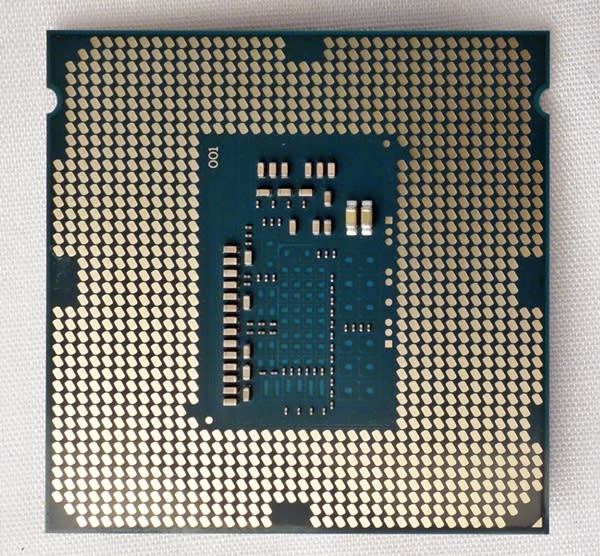
The Intel Core i7-5775C CPU features the GT3e class Iris Pro 6200 iGPU, which consists of 48 execution units. The graphics core operate with a base clock frequency of 300MHz, and they max out at around 1,150MHz.There’s also the presence of the L4 cache in the form of on-die 128MB eDRAM chips. Besides acting as a cache for the CPU cores, due to its lower latency and large bandwidth, it will boast the graphic compute performance of the iGPU.
The graphics core is stated to support up to 1.7GB of video memory, and this is shared with the system RAM. However, we were only able to "reserve" up to a maximum of 512MB of video memory from the UEFI BIOS utility of our test Intel Z97 motherboard. In this case, it was the MSI Z97 Gaming 9 AC. On the CPU side of things, this quad-core Broadwell processor has a base clock of 3.3GHz, and a Turbo Boost clock speed of 3.7GHz. It supports DDR3 memory modules that are rated up to 1,600MHz.
AMD A10-7870K (Godavari)
The A10-7870K APU was introduced as a breath of fresh air to the Kaveri desktop APUs. Parked under the Godavari series, the APU made its appearance in June 2015. It still uses Steamroller CPU cores, just like the older Kaveri APUs; however, the A10-7870K’s CPU cores operate at a higher base clock speed of 3.9GHz, in comparison with the Kaveri A10-7850K, which has a base clock speed of 3.7GHz. In terms of their dynamic boost clock speeds, the Godavari APU CPU cores peaked at 4.1GHz, which is just 100MHz higher than its Kaveri compatriot.
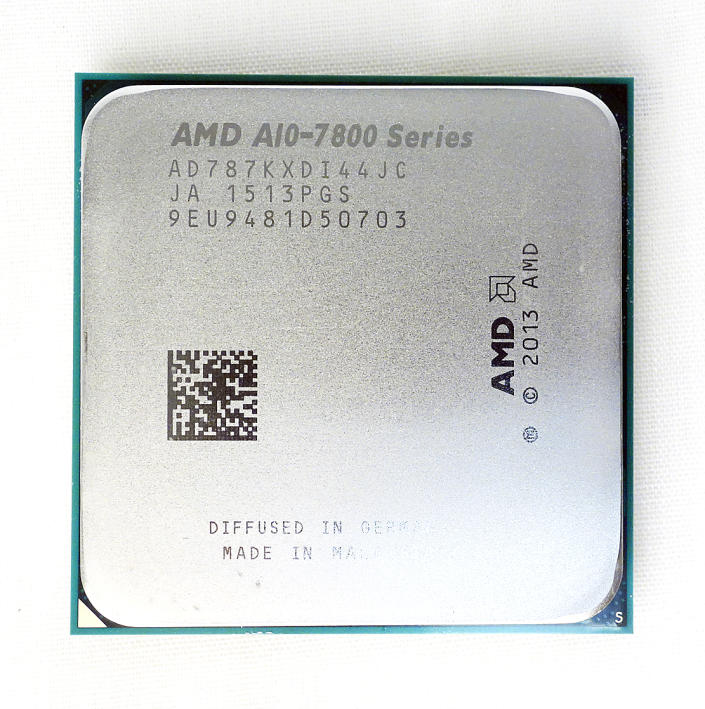
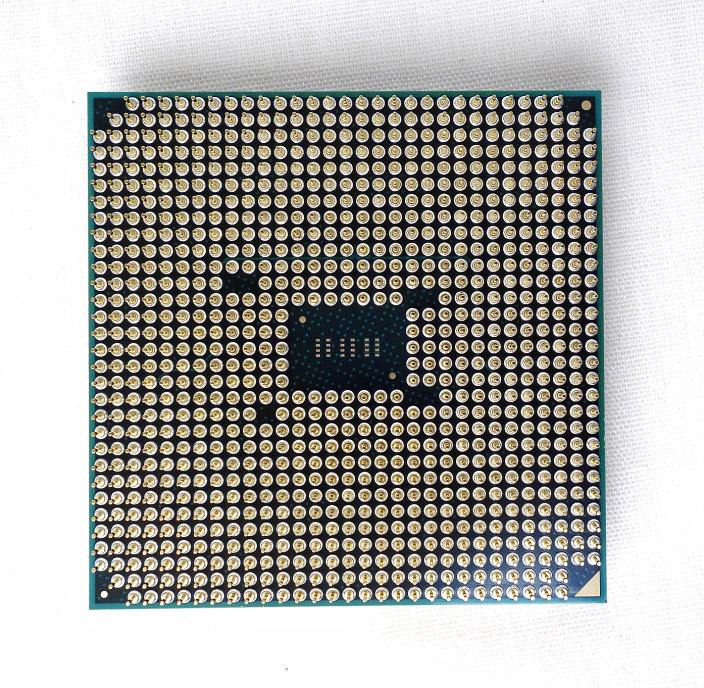
The A10-7870K is effectively a quad-core CPU, and this pits it against similarly-specced, dual-core Intel processors like the Skylake Core i3-6320, especially in running multi-threaded applications. For graphic compute matters, the A10-7870K features eight Radeon R7 graphics cores, and their operating frequencies are rated up to 866MHz. This is slightly over 20% higher than the A10-7850K APU. For its video memory, we were able to use the UEFI BIOS utility of our testbed Socket FM2+ motherboard to increase its video memory allocation to a size of 2GB! This is roughly about four times that of the Iris Pro 6200 iGPU of the competing Intel CPU. Let’s find out if this puts the AMD camp in an advantageous position.
|
|
|
|
|
|
|
|
|
|
|
|
|
|
|
|
|
|
|
|
|
|
|
|
|
|
|
|
|
|
|
|
|
|
— |
|
— |
|
— |
|
— |
|
Test Setup
The AMD test rig's motherboard was the ASUS A88X-Pro and we paired with G.Skill RipjawX DDR3-2133 memory modules. We used the automatic timings for the memory modules after we set their operating frequency to the official supported clock speed of 2,133MHz. As we had mentioned earlier, the video memory for the A10-7870K Radeon R7 graphics cores was set to the maximum of 2GB.
For the Intel Core i7-5775C, the MSI Z97 Gaming AC motherboard was fielded, and it was paired with Crucial Ballistix Elite Series DDR3-2133 RAM, which were downclocked to operate at 1600MHz (the official spec of the Intel processor). The video memory size for the Intel Iris Pro 6200 iGPU was set to the maximum of 512MB. The details of each test rig are as follows:-
AMD A10-7870K test system configuration
ASUS A88X-Pro (AMD A88X Bolton D4 chipset), BIOS version 2103
2 x 4GB G.Skill RipjawsX DDR3-2133 (Auto timings: CAS 9-10-11-28)
AMD Radeon R7 (AMD Catalyst 15.7 driver)
Seagate 600 series 240GB SATA 6Gbps solid state drive (one single NTFS partition; OS + benchmarks + games)
Windows 10 Home (64-bit)
Intel Core i7-5775C test system configuration
MSI Z97 Gaming 9 AC (Intel Z97 Express chipset), BIOS version 1.C
2 x 4GB Crucial Ballistix Elite Series DDR3-1600 (CAS 9-9-9-27)
Intel Iris Pro Graphics 6200 (Intel Graphics Driver 10.18.15.4256)
Kingston HyperX series 240GB SATA 6Gbps solid state drive (one single NTFS partition; OS + benchmarks + games)
Windows 10 Home (64-bit) with Intel INF 9.4.4.1006
Benchmarks
We have updated the benchmark titles and the stalwart 3DMark (2013) is the sole artificial testing software title. To test out the support for DirectX 11 gaming, we still roped in Tomb Raider, to ascertain how the IGPs handle it under the game's normal quality settings. Last of all, we tested the multimedia capabilities of the chips using Handbrake video encoding software and Blu-ray playback, with an updated version of PowerDVD 15 Ultra. The following is the full list of benchmarks used to test the integrated graphics engines:
3DMark (2013)
Tomb Raider
Handbrake Video Encoding
Blu-ray Playback Testing (Black Snake Moan, Superman Returns) using PowerDVD 15 Ultra (ver. 15.0.2003.58)
So read on for the iGPU performance showdown on the next page between Intel and AMD!
Integrated Graphics Performance
3DMark (2013) Results
For the 3DMark (2013) tests, we would usually use the Fire Strike Extreme to stress out the GPU cores; however, the AMD APU had some issues with the test, so we were had to deviate from norm and use the Sky Diver and Fire Strike tests. Do note the following differences between the respective test rigs.
The official operating clock speed of the memory modules for the Intel processor is kept at 1600MHZ, while for the AMD APU, its official supported clock speed is 2133MHz.
the video memory for the Core i7-5775C was capped at a maximum of 512MB, and for the A10-7870K, its video memory was set to a maximum of 2GB.
For the Sky Diver test, the A10-7870K pulled ahead by less than 1%; however, for the more demanding Fire Strike test, the higher video memory and its higher clock speed of the system RAM, the AMD APU managed a 5.2% winning margin against the Intel CPU.
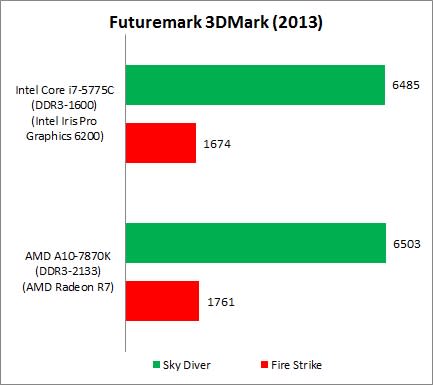
Tomb Raider
We put the game settings to the generic Normal mode, and tested the processors at two resolutions. The Intel Core i7-5775C pulled ahead slightly, but at the higher resolution of 1,920 x 1,200 pixels, their scores flatlined at 26fps.
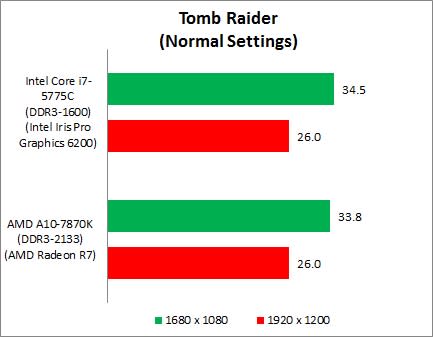
Handbrake Video Encoding
For the video encoding test, we upgraded the Handbrake software to version 0.10.2. The CPU prowess of the Core i7-5775C is evident despite the fact that Handbrake is supposed to support AMD's transcoding engine. The Intel processor was almost twice as fast the AMD APU for this test.
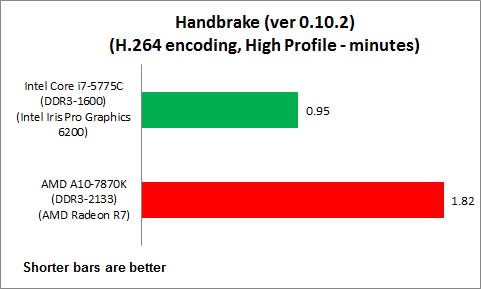
Video Decoding Performance - Blu-ray Playback
For our video decoding performance tests, the results swung back in favor, albeit only slightly, for the A10-7870K APU. In the past, we were used to CPU workloads of about 4- to 10%, and this was seen on our older Windows 7 testing platforms. However, with our new Windows 10 Home operating system, the CPU utilization loads are now in the range of 14- to 20%.

Overall Performance
SYSmark 2014 results
Given the neck-to-neck graphics performance of both processors, we decided to throw in an additional benchmark, SYSmark 2014, in order to gauge the overall performance of each. As expected, the Intel Core i7-5775C processor pulled ahead by a wide margin of 128% for the test's overall score. The benchmark measures the response times of the PC against a slew of application workloads, so the higher the scores, the faster the response times of the system. By looking at the overall score again, we can safely conclude the Intel system is about twice as fast the AMD machine.
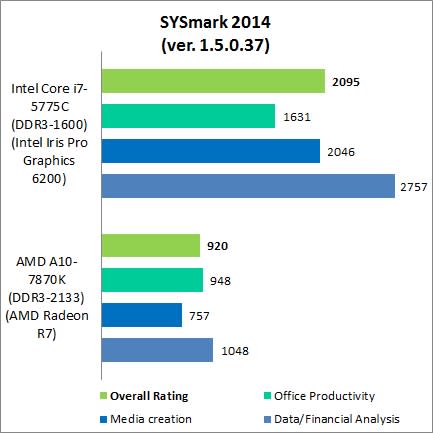
Concluding Thoughts
From the iGPU test results, it appears the A10-7870K and its Radeon R7 graphics engine has pulled ahead of the Intel chip. However, on further examination with the SYSmark 2014 benchmark, the Intel Core i7-5775C and its Iris Pro 6200 graphics core is easily the highest performing integrated graphics engine equipped processor. This is because of the strong overall performance of the Intel Broadwell processor, but we have to admit that from a technical point of view, the AMD processor is no match for the Intel processor - they are simply too big a different apart. The AMD A10-7870K is squarely a mid-range part and is closer to a true dual-core processor than a quad-core processor (at least going by traditional CPU architectures). Its price is also another dead giveaway of its intended category at just US$137. In comparison, the Intel Core i7-5775C is a high-end quad-core processor that has a suggested retail price of US$377 - nearly thrice as as expensive as the Intel counterpart.
So is our test unfair? Not at all. We set out to test the best iGPU based processors and that we did.

What's actually surprising is to see how well Intel's iGPU processor performed and it's clearly toe-to-toe with the best AMD has to offer - which is rather unheard of in the realms of Intel's integrated graphics. The Intel Iris Pro 6200 GPU has a total of 48 execution units, which is more than double in quantity, in comparison with the 20 EUs of the previous generation Intel HD Graphics 4600. In addition, there's also the presence of 128MB of eDRAM on the CPU package. What's more, Intel has managed to keep the thermal envelope of the entire chip to a low of 65W. This is definitely helped by the 14nm fabrication process behind the chip wafer. In comparison, the AMD A10-7870K APU has a higher thermal package of 95W with no significant microarchitecture difference between the current Godavari and the previous Kaveri A10-7850K APU.
In closing, if you want our recommendation for the best iGPU processor that offers great value, go for the AMD A10-7870K APU. If you really want the most powerful iGPU processor, the Intel Core i7-5775C no doubt takes the title. Either way, you can't go wrong and it's just a matter of your expectations.


